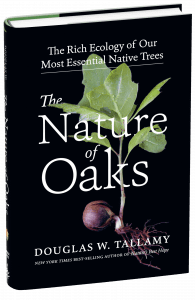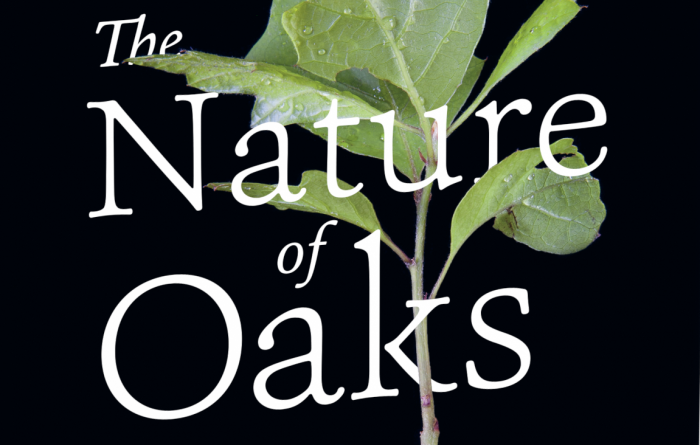Reviewed by John Turner
Ecologists (scientists who study the interactions between wild things and their environment) many decades ago coined the term “keystone species.” The term is derived from the fact that like the keystone in the middle of the top of a doorway’s arch, being the stone which supports the entire arch, keystone species in natural communities have disproportional ecological importance in maintaining the stability and integrity of the communities in which they live. Lose a “keystone” species and the community or ecosystem is adversely changed.
If we were to search the breadth and width of Long Island, might we find a keystone species? Doug Tallamy would certainly suggest oak trees as we learn in his recently released book, The Nature of Oaks: The Rich Ecology of Our Most Essential Native Trees.

Being important members of various types of forests, a dozen species of oak are native to Long Island including white oak; swamp white oak; black oak; red oak; scarlet oak (most common in the Pine Barrens); pin oak; the exceedingly rare willow oak; post oak (a coastal species); blackjack oak; chestnut oak found in rocky and gravelly soils; and scrub oak and dwarf chestnut oak, both common species forming an almost impenetrable thicket in the understory of the Pine Barrens.
What might be the elements of the oaks’ “keystoneness”? Well, there’s both their intact and fallen leaves, a resource for wildlife; those nuggets of nutrition called acorns; the nooks and crannies of the bark that provide hiding places for small moths and spiders; and the tree wood itself which, as it rots, forms cavities, creating roosting and nesting sites (think raccoons, woodpeckers, screech owls and chickadees). All of these attributes support wildlife, many species of wildlife. Not to mention, as Tallamy explains, the numerous “ecosystem services” oak trees and oak-dominated forests provide free of charge.
As but a few examples we learn that the canopy of each mature oak tree intercepts about 3,000 gallons of water annually, preventing it from running off and causing erosion, thereby helping to protect streams and rivers. And there’s the locking away of carbon that oak trees do really well, as a means to combat climate change.
Let’s take a closer look at an obvious attribute: acorns. This unique nut, high in fat, protein, and minerals is a vital food to more than just the obvious species like squirrels and chipmunks. These nuggets of nutrition sustain a surprisingly large variety of animals including mice and voles, flying squirrels, raccoons, rabbits, opossum, grey fox, white-tailed deer, and black bear.
As for birds, blue jays love them (and are thought to have been the main dispersal agent allowing for the oak forests of the northern United States to become reestablished after the glaciers scoured the continent) as do crows, some other songbirds, several species of ducks, turkeys, and woodpeckers, including the acorn woodpecker which really likes them.
We learn from the book that several butterflies (as caterpillar larvae) and more than 70 moth species gain required nutrition by feeding on the fallen leaves of oaks. Further, many insects seek protection in the fallen leaf layer that accumulates each autumn to overwinter safely (think of Mourning Cloak butterflies as one species that benefits), providing a rationale to leave your leaves in flower beds, beneath oak trees, and other parts of your yard.
 But it’s live oak leaves, Tallamy explains, where the value of oaks come into full focus. More than 500 species of butterflies and moths feed on oak leaves, including many geometrid caterpillars (or inchworms as we learned in our childhoods). Many hundred more other insect species eat oak leaves (or tap into the sap of oaks too), including leafhoppers, treehoppers, and cicadas, among others. These leaf-eating species, in turn, sustain many dozens of songbird species we love to watch — warblers, orioles, thrushes, wrens, chickadees, grosbeaks and more.
But it’s live oak leaves, Tallamy explains, where the value of oaks come into full focus. More than 500 species of butterflies and moths feed on oak leaves, including many geometrid caterpillars (or inchworms as we learned in our childhoods). Many hundred more other insect species eat oak leaves (or tap into the sap of oaks too), including leafhoppers, treehoppers, and cicadas, among others. These leaf-eating species, in turn, sustain many dozens of songbird species we love to watch — warblers, orioles, thrushes, wrens, chickadees, grosbeaks and more.
This book is a logical and more specific extension of Tallamy’s decade long argument, laid out in detail in two previous works: Bringing Nature Back Home: How You Can Sustain Wildlife With Native Plants and Nature’s Best Hope: A New Approach to Conservation that Starts in Your Yard.
In these prior works he makes a compelling argument for eliminating the “biological deserts” we’ve created around our homes, due to regularly choosing non-native plants that don’t sustain local wildlife, and replacing them with native species that are part of the local food web.
In “Oaks,” Tallamy backs up this recommendation with good science. For example, working with graduate students he found that non-native plants supported 75% less caterpillar biomass than native plants. Less caterpillars means less things that feed upon them, such as the aforementioned beloved songbirds. Another graduate student determined that chickadees trying to raise young in a habitat with too many non-native species are 60% less likely to succeed due to the dearth of insects to feed their nestlings.
Tallamy weaves a clear story documenting the ecological importance of oaks for wildlife while illustrating this significance through fascinating life history details of some of these many oak-dependent species. As with his other books, Tallamy’s latest publication provides strong motivation and rationale to “go native.” Perhaps most central to the thesis of the book is that he wants you to include oak trees as a key part of this effort! What better way to celebrate Earth Day 2021 than by planting an oak and watch as it sustains life for decades to come?
—————————————————–
Author Doug Tallamy is a professor in the Department of Entomology and Wildlife Ecology at the University of Delaware, where he has taught insect-related courses for 40 years. The Nature of Oaks is available at Book Revue in Huntington and online at www.timberpress.com, www.amazon.com and www.barnesandnoble.com. For more information on the author, visit www.bringingnaturehome.net.





